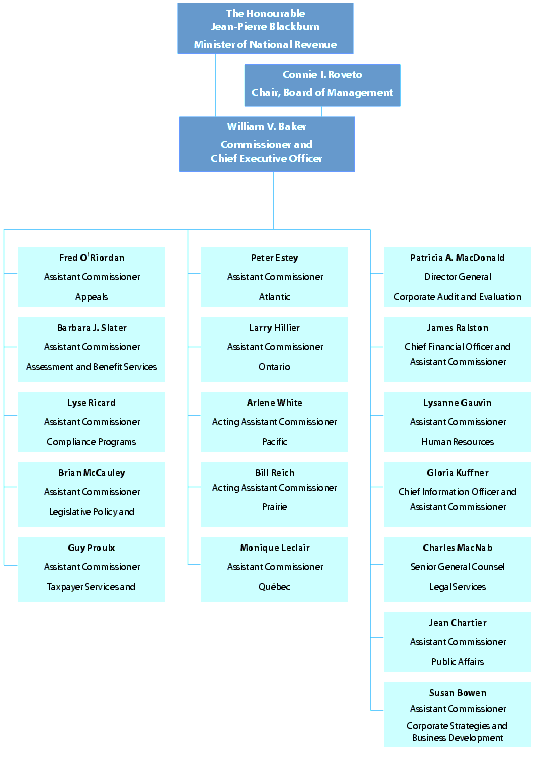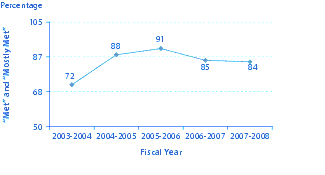Common menu bar links
Breadcrumb Trail
ARCHIVED - Canada Revenue Agency
 This page has been archived.
This page has been archived.
Archived Content
Information identified as archived on the Web is for reference, research or recordkeeping purposes. It has not been altered or updated after the date of archiving. Web pages that are archived on the Web are not subject to the Government of Canada Web Standards. As per the Communications Policy of the Government of Canada, you can request alternate formats on the "Contact Us" page.
Section IV: Other Items of Interest
4.1 The Governance Structure
Board of Management
The Board is composed of 15 members of which, four members including the Chair, and the Commissioner and CEO are nominated by the federal government; one director is nominated by each province; and one director is nominated by the territories.
The following list shows the Board's membership as of March 31, 2008.
Connie I. Roveto, B.A., B. Ed., ICD.D
Chair, Board of Management
President
Cirenity Management
Toronto, Ontario
Camille Belliveau, CFP, FCGA
Executive Director
Groupe EPR Canada Group Inc.
Shediac, New Brunswick
Myles Bourke, B. Comm., FCA
Corporate Director
Chartered Accountant
Lethbridge, Alberta
Raymond Desrochers, B. Comm., CA, CFE
Partner
BDO Dunwoody LLP Chartered Accountants
Winnipeg, Manitoba
Gordon Gillis, B.A., LL.B.
Lawyer/Consultant
Dartmouth, Nova Scotia
Andr� Gingras
Founder and Director
Andr� Gingras et Associ�s inc.
Montr�al, Quebec
Robert J. (Bob) Healey, B. Comm., CFP, FCA
Corporate Director
Chartered Accountant / Management Consultant
St. John's, Newfoundland and Labrador
James J. Hewitt, FCMA
Corporate Director
Penticton, British Columbia
Howard A. Leeson, Ph.D.
Senior Policy Fellow
Saskatchewan Institute of Public Policy
Regina, Saskatchewan
Rod Malcolm, CA
Corporate Director
Iqaluit, Nunavut
Patricia J. Mella, B.A., B.Ed., M.A.
Corporate Director
Stratford, Prince Edward Island
James R. Nininger, B. Comm., M.B.A., Ph.D.
Corporate Director
Ottawa, Ontario
Stephen E. Rudin, MSPH, M. Ed., CHE
Health Care Consultant
Toronto, Ontario
Sylvie Tessier, B. Sc., M.B.A., P.Eng., ICD.D
Consulting Director
Sierra Systems
Toronto, Ontario
William V. Baker, B.A., M.A., ICD.D
Commissioner and Chief Executive Officer
Canada Revenue Agency
Ottawa, Ontario
Organizational Structure

4.2 External Service Standards in the Agency
We believe that providing high quality service facilitates compliance with Canada's tax system. To that end, we are committed to providing taxpayers and benefits recipients with service that is:
Our service standards state the level of performance that Canadians can reasonably expect to encounter from the CRA under normal circumstances. Service standards that are reasonable and that the CRA meets contribute to our efforts to promote compliance. Service standards that are consistently met also contribute toward increasing the level of confidence that Canadians place in government.
How we set targets
The CRA sets targets that represent the percentage or degree of expected attainment of an established standard. Targets are based on operational realities, historical performance, complexity of the work, and Canadians' expectations. For example, standards for front-end processing generally have shorter time frames and/or higher targets, while those requiring greater review and analysis have lengthier time standards and/or lower targets.
We review our standards and targets annually. This year, we introduced five new standards, two in the Tax Services and three in the Benefit Programs areas. Two existing standards were amended: the Charities telephone service was amended to be more consistent with other telephone services; and T2 processing targets were combined and the standard improved (historical results are therefore not available for this standard).
Overall results
Overall, we met or mostly met 37 of the targets measured in 2007-2008. Our performance dropped marginally this year due to difficulty in meeting Registered Plans' standards. This was a result of high staff turnover and subsequent training requirements.
Figure 7 Service Standards With Targets That Are Met and Mostly Met

Challenges
We did not meet our target for the processing of Statements of Interim Payments. The decline in performance was related to the challenges experienced with the redeveloped GST/HST system and the consolidation of the sites where we print these statements.
In addition, we experienced difficulty in meeting our target regarding processing requests to authorize or cancel a representative during non-peak periods. We will review workflow efficiencies and the appropriateness of the standard in the context of the workload.
The decreased performance with respect to the GST/HST Visitor Rebates Program was due to the combined effects of the elimination of the program effective April 1, 2007, and the introduction of the Foreign Convention and Tour Incentive Program at the same time.
4.3 Responses to the Public Accounts Committee and the Office of the Auditor General of Canada
Action Plans – Item Listing
Tracking of actions to address the recommendations of the Public Accounts Committee (PAC) and the Office of the Auditor General of Canada.
For supplementary information on the Agency's Responses to the Public Accounts Committee and the Office of the Auditor General, please visit: http://www.oag-bvg.gc.ca/internet/English/parl_lpf_e_932.html
Benefit Programs and Benefit-Related Services Delivered by the CRA
- Canada Child Tax Benefit
- Universal Child Care Benefit1
- Goods and Services Tax / Harmonized Sales Tax Credit
- Children's Special Allowances
- Disability Tax Credit
4.4 Rating Our Data Quality
In conjunction with the performance results ratings, we also assign each indicator a data quality rating.
For each indicator we use consistent approaches in evaluating the information derived from our data collections systems and all other sources. We rely upon CRA managers to vouch for the completeness of the records for data integrity purposes (i.e., data belongs to the same category, is collected for the same period, and by the same method). We examine data for relevance, formulas for accuracy, and other factors that must be considered. We also use comparable information from prior years for the purpose of historical comparison, which often appears in the Annual Report. To ensure consistency, we perform the following tasks to verify that the information reported in our numerous reports is valid, reliable, and is accompanied by appropriate evidence:
- Validation: This is a process of verification to ensure that the data meets the requirements for its intended purposes. We review and evaluate data for completeness and plausibility (accuracy, timeliness, interpretability, coherence). We also identify contact information, check calculations, confirm system reliability (verifying the source of information), and note and address any errors.
- Data quality assessment: We apply a data quality checklist and review prior years' data to assess the quality of data for each indicator.
- Electronic filing system: We store data in a database for easy reference and further analysis for other purposes.
- Physical filing system: We maintain physical files of the evidence collected from all sources to provide validation and assurance that our data quality ratings are accurate and supported.
We always endeavour to use the most appropriate and reliable data when evaluating our results. There are mainly two data sources for the Annual Report: administrative data (normally communicated in aggregate or after some simple calculations are performed on them) and survey data. All data sources are validated for accuracy and a data quality rating of good, reasonable or weak as categorized below is applied to each indicator.
We believe that these three levels of data quality ratings provide a reasonable assessment of the reliability of the data. Generally, our data sources provide reliable information. In situations where the supporting data is too imprecise to draw firm conclusions, it is reflected in the data quality rating.
